A Discussion on Winter Indoor Hygrothermal Conditions and Hygroscopic Behaviour of Plasters in Southern Europe
Abstract
1. Introduction
2. Materials and Methods
2.1. Case Studies Selected and Indoor Monitoring Campaign
2.2. Statistical Analysis of Indoor Hygrothermal Conditions and Indoor Comfort
2.3. Plaster Characterization
- E—commercial plaster based on clayish earth produced by EMBARRO [38] with a consistence by flow table of 170 ± 10 mm;
- CL—1:3 volumetric ratio of hydrate air lime CL 90-S and siliceous sand (0–4 mm) with a consistence by flow table of 151 ± 5 mm;
- NHL—1:3 volumetric ratio of natural hydraulic lime NHL3.5 and siliceous sand (0–4 mm) with a consistence by flow table of 150 ± 5 mm;
- Cem—1:4 volumetric ratio of CEM II/B-L 32.5N and siliceous sand (0–2 mm) with a consistence by flow table of 140 ± 3 mm.
2.4. Numerical Simulations
2.4.1. Simulations under Standard Conditions
2.4.2. Simulations under Realistic Operational Conditions
3. Results and Discussion
3.1. Indoor Climate
3.2. Statistical Evaluation
3.3. Indoor Comfort
3.4. Sorption Isotherms of the Plasters
3.5. Simulations
3.5.1. Simulations under Standard Conditions
3.5.2. Simulations under Realistic Operational Conditions
4. Conclusions
- The microclimates of the four case studies are found to be well represented by the hygrothermal ranges of 63–76% RH and 17.5 ± 1.5 °C, which were defined considering the 25th and 75th percentiles of the dataset distributions.
- In terms of RH, the ISO 24353 sets the closest values to the characteristic ranges defined for the four case studies according to the monitoring. The standard adopts the condition 50% to 75% RH, differently from the NORDTEST procedure, which is typically used considering the range 33–75% RH. Overall, the humidity range adopted in the ISO standard appears more representative of the microclimates observed on-site. Indeed, the lower RH value adopted in the NORDTEST (33%) is rarely reached in the datasets presented in this study. RH below this value is observed for less than 5% of the time and only in two case studies.
- Considering the temperature, the values prescribed in both the ISO 24353 standard and the NORDTEST protocol (22.5–23.5 °C) are higher than those observed in the case studies during almost the entire wintertime.
- In terms of indoor comfort, it was observed that the case studies are often out of the comfort area—over 50% of wintertime—mainly due to high relative humidity and low temperature. This outcome is consistent with the complaints of the bedrooms’ users. Furthermore, it is aligned with the literature concerning the inability of keeping residential spaces sufficiently warm in Southern Europe.
- The fluctuation in the moisture content of the plasters was qualitatively in agreement with the ranking based on the MBV determined by both the NORDTEST procedure and ISO 24353 standard. Thus, the standard test procedures for evaluating the moisture buffering capacity of building materials might be representative also for the context of Southern European housing, despite its colder and moister indoor conditions. Further studies are needed to evaluate this point more in depth, accounting for the more accurate results obtainable through whole-building simulation models.
- The earth-based plaster, above all, showed the widest fluctuations in water content under realistic operational conditions. This result suggests that this material could be promising for passive regulation of indoor relative humidity.
Author Contributions
Funding
Institutional Review Board Statement
Acknowledgments
Conflicts of Interest
References
- Diffey, B.L. An overview analysis of the time people spend outdoors. Br. J. Dermatol. 2011, 164, 848–854. [Google Scholar] [CrossRef] [PubMed]
- Curado, A.; Freitas, V.P.; Ramos, N.M. Variability assessment of thermal comfort in a retrofitted social housing neighborhood based on “in situ” measurements. Energy Procedia 2015, 78, 2790–2795. [Google Scholar] [CrossRef][Green Version]
- Barbosa, F.C.; Freitas, V.P.; Almeida, M. School building experimental characterization in Mediterranean climate regarding comfort, indoor air quality and energy consumption. Energy Build. 2020, 212, 109782. [Google Scholar] [CrossRef]
- Caro, R.; Sendra, J.J. Are the dwellings of historic Mediterranean cities cold in winter? A field assessment on their indoor environment and energy performance. Energy Build. 2021, 230, 110567. [Google Scholar] [CrossRef]
- Almeida, R.M.; Freitas, V.P. IEQ assessment of classrooms with an optimized demand controlled ventilation system. Energy Procedia 2015, 78, 3132–3137. [Google Scholar] [CrossRef]
- Darling, E.K.; Cros, C.J.; Wargocki, P.; Kolarik, J.; Morrison, G.C.; Corsi, R.L. Impacts of a clay plaster on indoor air quality assessed using chemical and sensory measurements. Build. Environ. 2012, 57, 370–376. [Google Scholar] [CrossRef]
- Wolkoff, P. Indoor air humidity, air quality, and health—An overview. Int. J. Hyg. Environ. Health 2018, 221, 376–390. [Google Scholar] [CrossRef]
- McGregor, F.; Heath, A.; Maskell, D.; Fabbri, A.; Morel, J.C. A review on the buffering capacity of earth building materials. Proc. Inst. Civ. Eng. Constr. Mater. 2016, 169, 241–251. [Google Scholar] [CrossRef]
- Liuzzi, S.; Stefanizzi, P. Experimental study on hygrothermal performances of indoor covering materials. Int. J. Heat Technol. 2016, 34, S365–S370. [Google Scholar] [CrossRef]
- Ferreira, C.; de Freitas, V.P.; Delgado, J.M.P.Q. The influence of hygroscopic materials on the fluctuation of relative humidity in museums located in historical buildings. Stud. Conserv. 2020, 65, 127–141. [Google Scholar] [CrossRef]
- Posani, M.; Veiga, M.R.; de Freitas, V.P. Towards resilience and sustainability for historic buildings: A review of envelope retrofit possibilities and a discussion on hygric compatibility of thermal insulations. Int. J. Archit. Herit. 2021, 15, 807–823. [Google Scholar] [CrossRef]
- Ramos, N.M.; de Freitas, V.P. The evaluation of hygroscopic inertia and its importance to the hygrothermal performance of buildings. In Heat and Mass Transfer in Porous Media; Springer: Berlin, Germany, 2012; pp. 25–45. [Google Scholar]
- Wargocki, P.; Wyon, D.P. Providing better thermal and air quality conditions in school classrooms would be cost-effective. Build. Environ. 2013, 59, 581–589. [Google Scholar] [CrossRef]
- Cintura, E.; Nunes, L.; Esteves, B.; Faria, P. Agro-industrial wastes as building insulation materials: A review and challenges for Euro-Mediterranean countries. Ind. Crops Prod. 2021, 171, 113833. [Google Scholar] [CrossRef]
- Cascione, V.; Maskell, D.; Shea, A.; Walker, P.; Mani, M. Comparison of moisture buffering properties of plasters in full scale simulations and laboratory testing. Constr. Build. Mater. 2020, 252, 119033. [Google Scholar] [CrossRef]
- Gonçalves, H.; Gonçalves, B.; Silva, L.; Vieira, N.; Raupp-Pereira, F.; Senff, L.; Labrincha, J.A. The influence of porogene additives on the properties of mortars used to control the ambient moisture. Energy Build. 2014, 74, 61–68. [Google Scholar] [CrossRef]
- Rode, C.; Peuhkuri, R.H.; Mortensen, L.H.; Hansen, K.K.; Time, B.; Gustavsen, A.; Ojanen, T.; Ahonen, J.; Svennberg, K.; Harderup, L.E.; et al. Moisture Buffering of Building Materials; Technical University of Denmark, Department of Civil Engineering: Lyngby, Danmark, 2005. [Google Scholar]
- Rode, C.; Peuhkuri, R. The Concept of Moisture Buffer Value of Building Materials and Its Application in Building Design. In Proceedings of the 8th International Conference and Exhibition on Healthy Buildings, Lisbon, Portugal, 4–8 June 2006. [Google Scholar]
- Rode, C.; Peuhkuri, R.H.; Time, B.; Svennberg, K.; Ojanen, T. Moisture buffer value of building materials. In Heat-Air-Moisture Transport: Measurements on Building Materials; ASTM International: West Conshohocken, PA, USA, 2007; pp. 111–122. [Google Scholar]
- ISO 24353; Hygrothermal Performance of Building Materials and Products—Determination of Moisture Adsorption/Desorption Properties in Response to Humidity Variation. International Organization for Standardization: Geneva, Switzerland, 2008.
- Magalhães, S.A.; de Freitas, V.P. A Complementary Approach for Energy Efficiency and Comfort Evaluation of Renovated Dwellings in Southern Europe. In Proceedings of the 11th Nordic Symposium on Building Physics, Trondheim, Norway, 11–14 June 2017. [Google Scholar]
- Magalhães, S.A.; de Freitas, V.P.; Alexandre, J.L. Energy Certification Label vs. Passive Discomfort Index for Existing Dwellings. In Proceedings of the XIII International Research-Technical Conference on the Problems of Designing, Construction and Use of Low Energy Housing, Krakow, Poland, 11–13 September 2018. [Google Scholar] [CrossRef]
- Atanasiu, B.; Kontonasiou, E.; Mariottini, F. Alleviating Fuel Poverty in the EU—Investing in Home Renovation, a Sustainable and Inclusive Solution; Buildings Performance Institute Europe (BPIE): Brussels, Belgium, 2014. [Google Scholar]
- Portuguese Regulation of Thermal Behaviour Characteristics of Buildings; Decreto-Lei n° 40/90, de 6 de Fevereiro; Portuguese Legislation: Lisbon, Portugal, 1990. (In Portuguese)
- INE; LNEC. The Housing Stock and Its Rehabilitation—Analysis and Evolution, 2013th ed.; Statistics Portugal—INE; National Laboratory for Civil Engineering—LNEC: Lisbon, Portugal, 2011; ISBN 978-989-25-0246-5. (In Portuguese) [Google Scholar]
- Posani, M.; Veiga, M.R.; de Freitas, V.P.; Kompatscher, K.; Schellen, H. Dynamic Hygrothermal Models for Monumental, Historic Buildings with HVAC Systems: Complexity Shown through a Case Study. In Proceedings of the 12th Nordic Symposium on Building Physics—NSB2020, Tallinn, Estonia, 6–9 September 2020. [Google Scholar] [CrossRef]
- Posani, M.; Veiga, M.R.; de Freitas, V.P. Thermal retrofit for historic massive walls in temperate climates: Risks and opportunities. In Proceedings of the 4° Encontro de Conservação e Reabilitação de Edifícios—ENCORE 2020, Lisbon, Portugal, 3–6 November 2020. [Google Scholar]
- Portuguese Institute for Sea and Atmosphere (Instituto Português do Mar e da Atmosfera)—IPMA. 2021. Available online: http://www.ipma.pt/pt/ (accessed on 14 June 2021).
- Portuguese Energy Regulation of Buildings; Despacho n° 15793-K/2013; Portuguese Legislation: Lisbon, Portugal, 2013. (In Portuguese)
- Italian Energy Regulation of Buildings; Decreto del Presidente della Repubblica n° 74 del 16 aprile 2013. 2013. Available online: https://www.gazzettaufficiale.it/eli/id/2013/06/27/13G00114/sg (accessed on 13 February 2022). (In Italian).
- Chambers, J.M.; Cleveland, W.S.; Kleiner, B.; Tukey, P.A. Graphical Methods for Data Analysis, 1st ed.; Chapman and Hall/CRC: Boca Raton, FL, USA, 2017. [Google Scholar]
- ISO 7730; Ergonomics of the Thermal Environment—Analytical Determination and Interpretation of Thermal Comfort Using Calculation of the PMV and PPD Indices and Local Thermal Comfort Criteri. International Organization for Standardization: Geneva, Switzerland, 2005.
- ASHRAE 55; Thermal Environmental Conditions for Human Occupancy. American Society of Heating, Refrigerating and Air-Conditioning Engineers: Atlanta, GA, USA, 2020.
- Peeters, L.; de Dear, R.; Hensen, J.; D’haeseleer, W. Thermal comfort in residential buildings: Comfort values and scales for building energy simulation. Appl. Energy 2009, 86, 772–780. [Google Scholar] [CrossRef]
- EN 16798-1; Energy Performance of Buildings—Ventilation for Buildings—Part 1: Indoor Environmental Input Parameters for Design and Assessment of Energy Performance of Buildings Addressing Indoor Air Quality, Thermal Environment, Lighting and Acoustics. European Committee for Standardization: Brussels, Belgium, 2019.
- EN 15251; Indoor Environmental Input Parameters for Design and Assessment of Energy Performance of Buildings Addressing Indoor Air Quality, Thermal Environment, Lighting and Acoustics. European Committee for Standardization: Brussels, Belgium, 2007.
- EN 1015-3; Methods of Test for Mortar for Masonry—Part 3: Determination of Consistence of Fresh Mortar (by Flow Table). European Committee for Standardization: Brussels, Belgium, 1999.
- Embarro Universal. Available online: https://www.embarro.com/en/ (accessed on 4 February 2022).
- Ranesi, A.; Faria, P.; Veiga, M.R. Traditional and modern plasters for built heritage: Contribution 2 for relative humidity passive regulation. Heritage 2021, 4, 2337–2355. [Google Scholar] [CrossRef]
- Santos, A.R. The Influence of Natural Aggregates on the Performance of Replacement Mortars for Ancient Buildings: The Effects of Mineralogy, Grading and Shape. Ph.D. Thesis, Instituto Superior Técnico, Lisbon, Portugal, 2019. [Google Scholar]
- Santos, A.R.; Veiga, R.; Santos Silva, A.; de Brito, J.; Álvarez, J.I. Evolution of the microstructure of lime based mortars and influence on the mechanical behaviour: The role of the aggregates. Contruction Build. Mater. 2018, 187, 907–922. [Google Scholar] [CrossRef]
- Pederneiras, C.; Veiga, R.; de Brito, J. Physical and mechanical performance of coir fiber-reinforced rendering mortars. Materials 2021, 14, 823. [Google Scholar] [CrossRef]
- Posani, M.; Veiga, R.; de Freitas, V.P. Thermal mortar-based insulation solutions for historic walls: An extensive hygrothermal characterization of materials and systems. Constr. Build. Mater. 2022, 315, 125640. [Google Scholar] [CrossRef]
- Fraunhofer Institute for Building Physics IBP. Available online: https://wufi.de/en/software/product-overview/ (accessed on 29 March 2021).
- Ferreira, C.; de Freitas, V.P.; Ramos, N.M. Quantifying the influence of hygroscopic materials in the fluctuation of relative humidity in museums housed in old buildings. In Proceedings of the 10th Nordic Symposium on Building Physics, Lund, Sweden, 15–19 June 2014. [Google Scholar]
- ISO 12571; Hygrothermal Performance of Building Materials and Products—Determination of Hygroscopic Sorption Properties. International Organization for Standardization: Geneva, Switzerland, 2013.
- Mundt Petersen, S.; Arfvidsson, J. Comparison of field measurements and calculations of relative humidity and temperature in wood framed walls. In Proceedings of the 15th International Meeting of Thermophysical Society, Valtice, Czech Republic, 3–5 November 2010. [Google Scholar]
- Mundt Petersen, S.; Harderup, L.H. Validation of a one-dimensional transient heat and moisture calculation tool under real conditions. In Proceedings of the Thermal Performance of the Exterior Envelopes of Whole Buildings XII International Conference, Clearwater, FL, USA, 1–5 December 2013. [Google Scholar]
- Alev, Ü.; Targo, K.; Marko, T.; Martti-Jaan, M. Air leakage and hygrothermal performance of an internally insulated log house. In Proceedings of the 10th Nordic Symposium on Building Physics—NSB 2014, Lund, Sweden, 15–19 June 2014. [Google Scholar]
- Stöckl, B.; Daniel, Z.; Hartwig, M.K. Hygrothermal simulation of green roofs-new models and practical application. In Proceedings of the 10th Nordic Symposium on Building Physics—NSB 2014, Lund, Sweden, 15–19 June 2014. [Google Scholar]
- Villmann, B.; Slowik, V.; Wittmann, F.H.; Vontobel, P.; Hovind, J. Time-dependent moisture distribution in drying cement mortars—Results of neutron radiography and inverse analysis of drying tests. Restor. Build. Monum. 2014, 20, 49–62. [Google Scholar] [CrossRef]
- Ferreira, C.; Freitas, V.P.; Delgado, J.M.P.Q. The influence of mass tourism and hygroscopic inertia in relative humidity fluctuations of museums located in historical buildings. In Building Pathology, Durability and Service Life; Delgado, J.M.P.Q., Ed.; Springer: Cham, Switzerland, 2020; Volume 12, pp. 121–144. [Google Scholar]
- Cascione, V.; Maskell, D.; Shea, A.; Walker, P. A review of moisture buffering capacity: From laboratory testing to full-scale measurement. Constr. Build. Mater. 2019, 200, 333–343. [Google Scholar] [CrossRef]
- Liuzzi, S.; Rubino, C.; Martellotta, F.; Stefanizzi, P.; Casavola, C.; Pappalettera, G. Characterization of biomass-based materials for building applications: The case of straw and olive tree waste. Ind. Crops Prod. 2020, 147, 112229. [Google Scholar] [CrossRef]
- Evrard, A.; De Herde, A. Hygrothermal performance of lime-hemp wall assemblies. J. Build. Phys. 2010, 34, 5–25. [Google Scholar] [CrossRef]
- Claude, S.; Ginestet, S.; Bonhomme, M.; Escadeillas, G.; Taylor, J.; Marincioni, V.; Korolija, I.; Altamirano, H. Evaluating retrofit options in a historical city center: Relevance of bio-based insulation and the need to consider complex urban form in decision-making. Energy Build. 2019, 182, 196–204. [Google Scholar] [CrossRef]
- Libralato, M.; De Angelis, A.; D’Agaro, P.; Cortella, G.; Qin, M.; Rode, C. Damage risk assessment of building materials with moisture hysteresis. In Proceedings of the 8th International Building Physics Conference, Copenhagen, Denmark, 25–27 August 2021. [Google Scholar] [CrossRef]
- Kunzel, H.M. Simultaneous Heat and Moisture Transport in Building Components; Fraunhofer Institute of Building Physics: Stuttgart, Germany, 1995; ISBN 3-8167-4103-7. [Google Scholar]
- Rode, C. Combined Heat and Moisture Transfer in Building Constructions. Ph.D. Thesis, Technical University of Denmark, Lyngby, Denmark, 1990. [Google Scholar]
- Pina dos Santos, C.A.; Rodrigues, R. ITE54—Thermal Transmission Coefficients of Opaque Elements of Building Envelope; National Laboratory of Civil Engineering: Lisboa, Portugal, 2009. (In Portuguese) [Google Scholar]
- Ramos, N.M.; Almeida, R.M.; Simões, M.L.; Delgado, J.M.; Pereira, P.F.; Curado, A.; Soares, S.; Fraga, S. Indoor hygrothermal conditions and quality of life in social housing: A comparison between two neighbourhoods. Sustain. Cities Soc. 2018, 38, 80–90. [Google Scholar] [CrossRef]
- Magalhães, S.A. Comparison between the Passive Discomfort Index and the Energy Class of Rehabilitated Residential Buildings in Southern Europe (Original title, in Portuguese: Comparação do Índice de Desconforto Passivo com a Classe Energéticade Edifícios de Habitação Reabilitados do Sul da Europa). Ph.D. Thesis, Faculty of Engineering of the University of Porto, Porto, Portugal, 2020; p. 85. [Google Scholar]
- Mazhoud, B.; Collet, F.; Pretot, S.; Chamoin, J. Hygric and thermal properties of hemp-lime plasters. Build. Environ. 2016, 96, 206–216. [Google Scholar] [CrossRef]
- Ramos, N.M.M.; Delgado, J.M.P.Q.; de Freitas, V.P. Influence of finishing coatings on hygroscopic moisture buffering in building elements. Constr. Build. Mater. 2010, 24, 2590–2597. [Google Scholar] [CrossRef]
- Kaczorek, D. Moisture buffering of multilayer internal wall assemblies at the micro scale: Experimental study and numerical modelling. Appl. Sci. 2019, 9, 3438. [Google Scholar] [CrossRef]
- Colinart, T.; Lelièvre, D.; Glouannec, P. Experimental and numerical analysis of the transient hygrothermal behavior of multilayered hemp concrete wall. Energy Build. 2016, 112, 1–11. [Google Scholar] [CrossRef]
- Goto, Y.; Wakili, K.G.; Frank, T.; Stahl, T.; Ostermeyer, Y.; Ando, N.; Wallbaum, H. Heat and moisture balance simulation of a building with vapor-open envelope system for subtropical regions. Build. Simul. 2012, 5, 301–314. [Google Scholar] [CrossRef]
- Du, Y.; Habert, G.; Brumaud, C. Influence of tannin and iron ions on the water resistance of clay materials. Constr. Build. Mater. 2022, 323, 126571. [Google Scholar] [CrossRef]
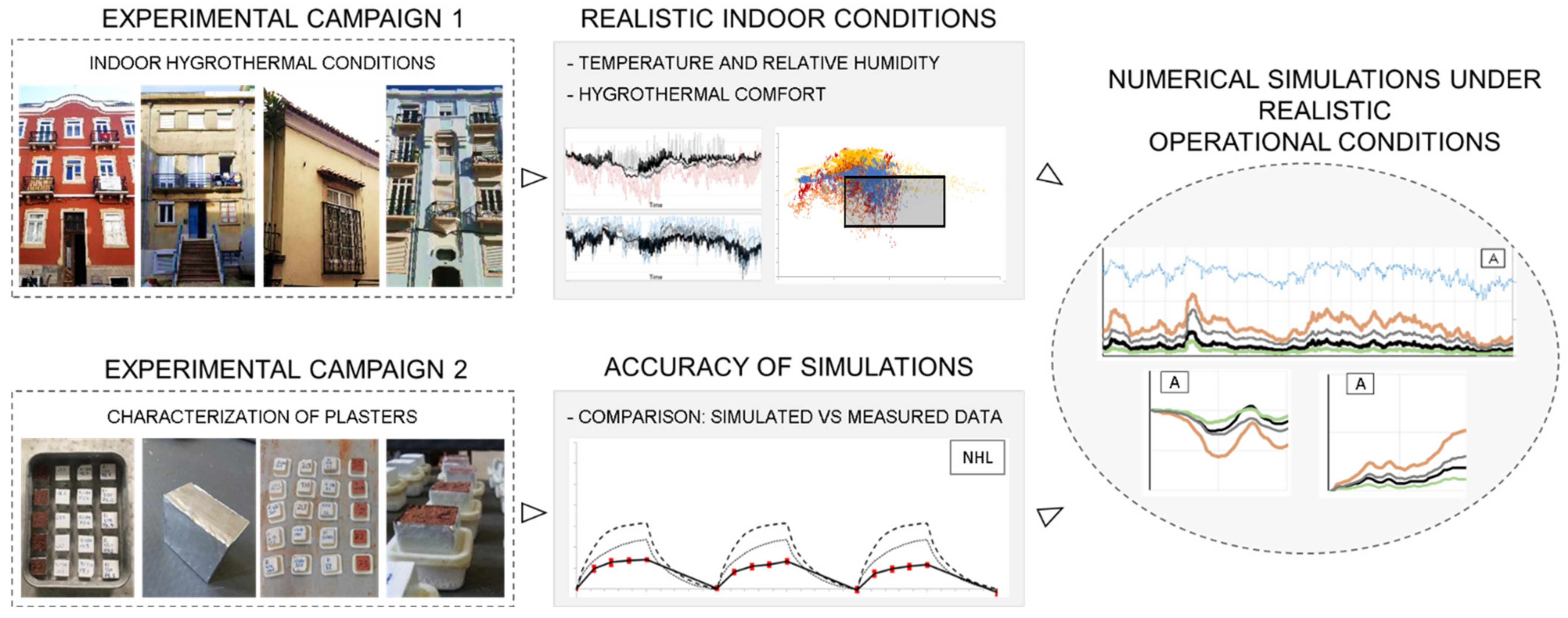


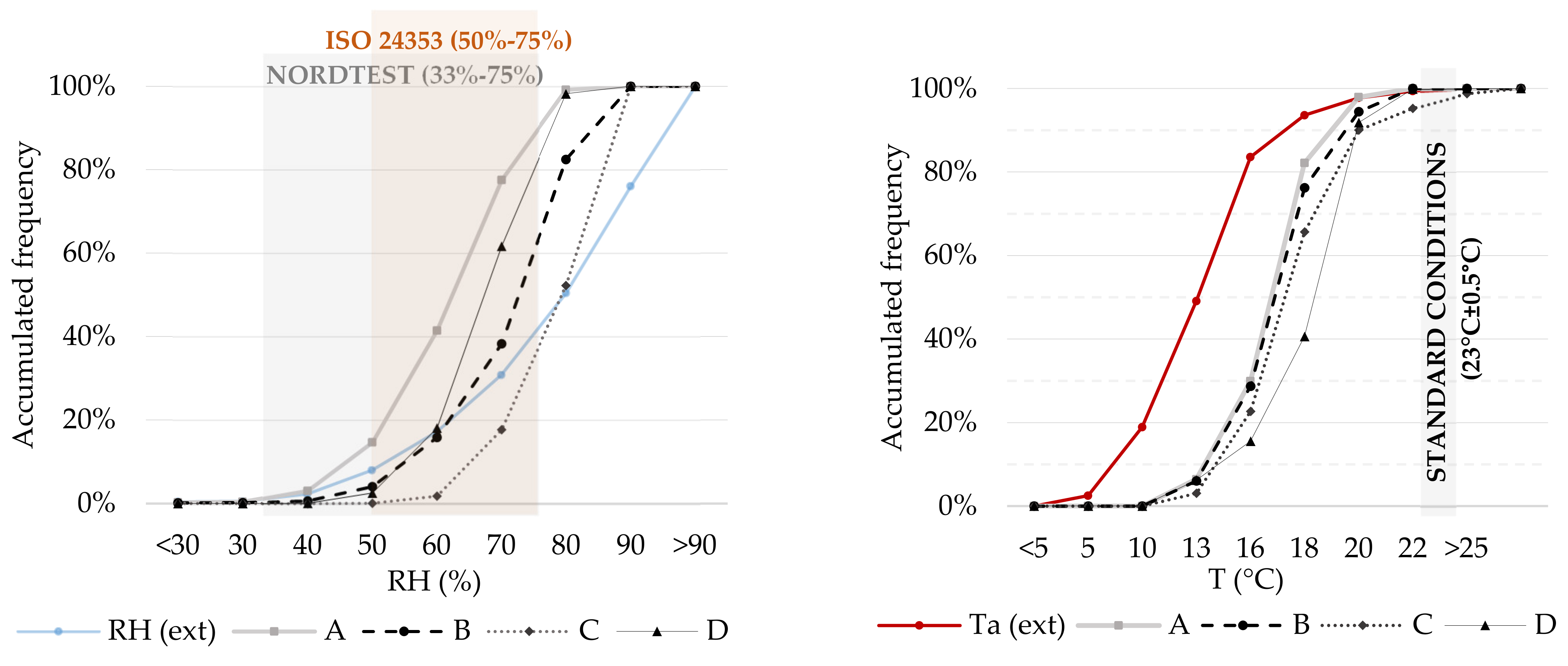


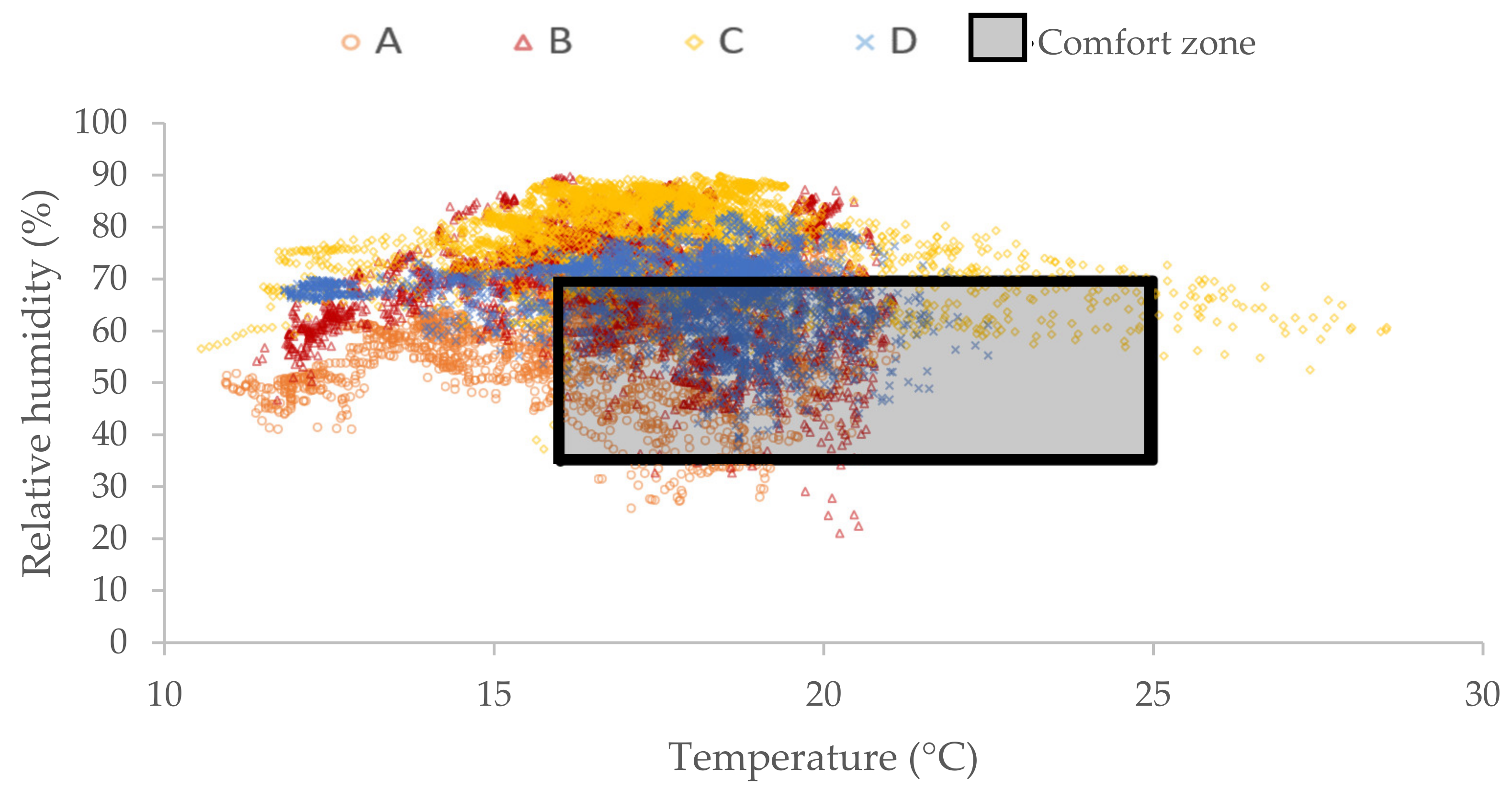

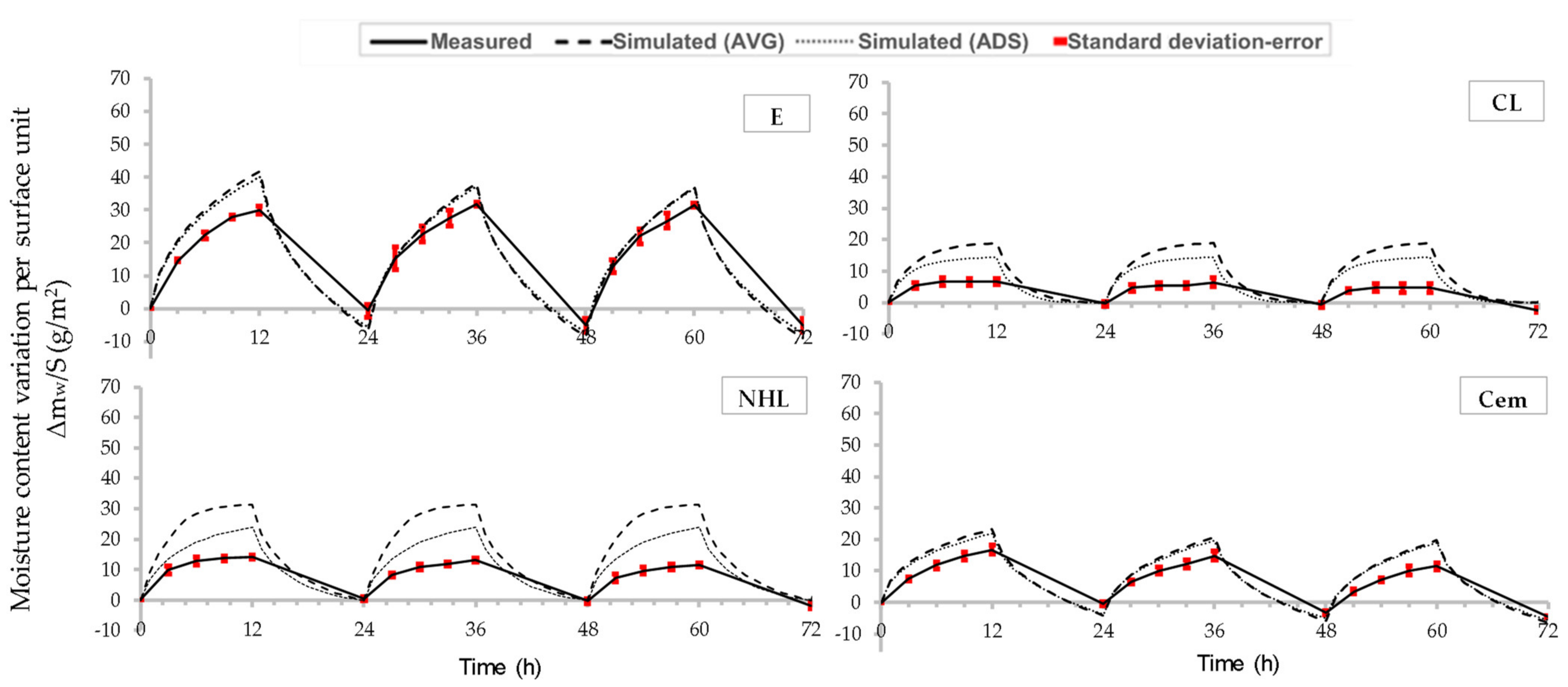
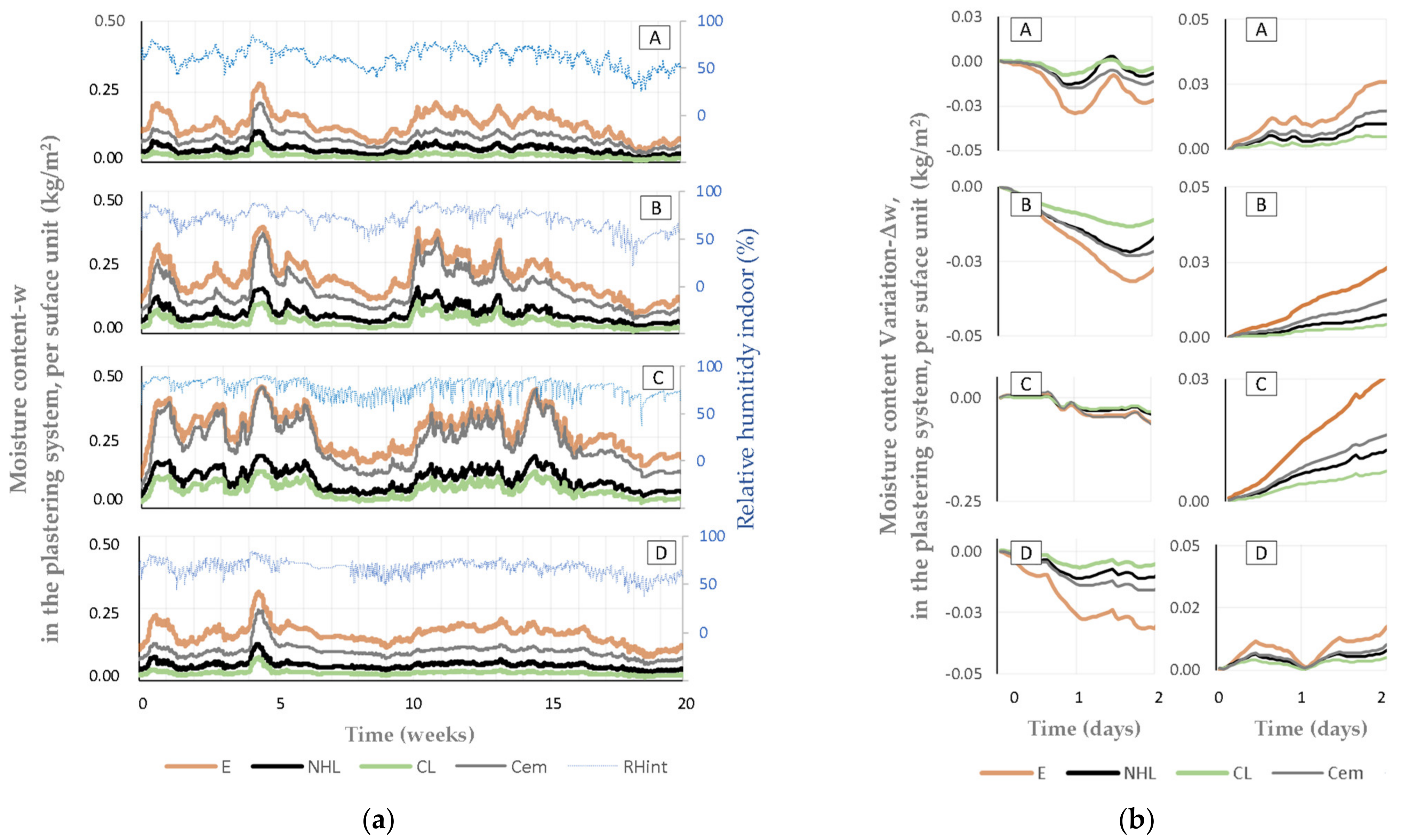
| Plaster | NORDTEST | ISO 24353 |
|---|---|---|
| E | 1.493 ± 0.09 | 1.327 ± 0.08 |
| CL | 0.416 ± 0.04 | 0.267 ± 0.03 |
| NHL | 0.799 ± 0.03 | 0.537 ± 0.02 |
| Cem | 0.843 ± 0.07 | 0.660 ± 0.05 |
| Plaster | Po (%) | ρDry (kg/m3) | µ (–) | Aw (kg/m2s0.5) | * λDry (W/(mK)) |
|---|---|---|---|---|---|
| E | 29.9 | 1743 | 9.07 | 0.50 | 0.5 |
| CL | 25.8 | 1720 | 7.43 | 1.71 | 0.7 |
| NHL | 26.2 | 1779 | 9.32 | 2.40 | 0.7 |
| Cem | 20.2 | 1919 | 20.42 | 0.43 | 1.2 |
Publisher’s Note: MDPI stays neutral with regard to jurisdictional claims in published maps and institutional affiliations. |
© 2022 by the authors. Licensee MDPI, Basel, Switzerland. This article is an open access article distributed under the terms and conditions of the Creative Commons Attribution (CC BY) license (https://creativecommons.org/licenses/by/4.0/).
Share and Cite
Ranesi, A.; Posani, M.; Veiga, R.; Faria, P. A Discussion on Winter Indoor Hygrothermal Conditions and Hygroscopic Behaviour of Plasters in Southern Europe. Infrastructures 2022, 7, 38. https://doi.org/10.3390/infrastructures7030038
Ranesi A, Posani M, Veiga R, Faria P. A Discussion on Winter Indoor Hygrothermal Conditions and Hygroscopic Behaviour of Plasters in Southern Europe. Infrastructures. 2022; 7(3):38. https://doi.org/10.3390/infrastructures7030038
Chicago/Turabian StyleRanesi, Alessandra, Magda Posani, Rosário Veiga, and Paulina Faria. 2022. "A Discussion on Winter Indoor Hygrothermal Conditions and Hygroscopic Behaviour of Plasters in Southern Europe" Infrastructures 7, no. 3: 38. https://doi.org/10.3390/infrastructures7030038
APA StyleRanesi, A., Posani, M., Veiga, R., & Faria, P. (2022). A Discussion on Winter Indoor Hygrothermal Conditions and Hygroscopic Behaviour of Plasters in Southern Europe. Infrastructures, 7(3), 38. https://doi.org/10.3390/infrastructures7030038









